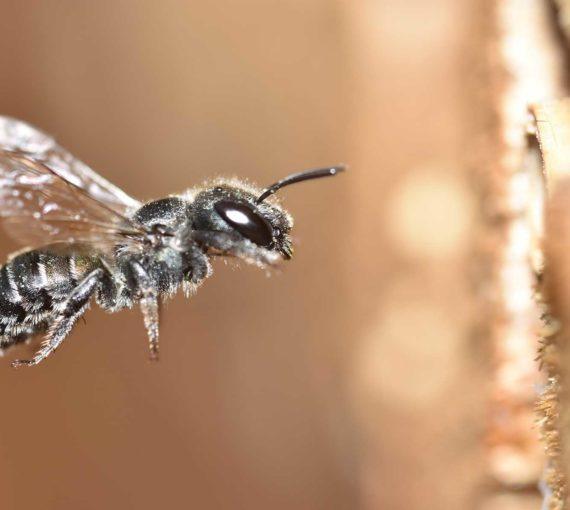
Most wild bees are solitary. They nest alone in crevices, hollow stems or underground burrows.
Wild bees need our help. Many populations are declining due to habitat loss, disease and pesticide poisoning.
As our most important pollinators, bees provide one-third of the food we eat. They also allow wild plants to reproduce and produce berries, fruits and seeds. Bee losses pose a risk to our life-support systems.
Native bees in Canada
There are 20,000 known bee species worldwide and more than 800 native bee species in Canada of all sizes — the smallest is the size of the head of a pin! Each is unique and pollinates different plants at different times. For example, squash bees are the best for squash, pumpkins and gourds. Every species is beneficial to plants.
Each of us can create habitat to support local bee populations. Bees are more likely to thrive in your backyard, community or patio garden and on mixed farms than on acres devoted to single crops. Urban settings mean short flight paths and a variety of different plants and flowers to sample.

Is that a bee, wasp or fly?
Learn how to distinguish bees, wasps and flies. That will help ensure your safety and peaceful coexistence with these important creatures. When you understand their roles and contributions, you can take steps to protect their habitats and support their populations.

The buzz on wild bees versus honeybees
Honeybee populations are growing and spreading from country to city, from backyards to gardens to rooftops. But many of the estimated 3,600 native wild bee species in North America — including about 800 in Canada — aren’t faring so well.
Five steps to create your wild bee sanctuary
1. Fill your yard with flowers
Bees rely on blooming wildflowers, shrubs and trees to provide food — nectar and pollen.
Flowers should blossom over the seasons, from early spring to late fall. Choose a diversity of native species of all shapes and sizes. Plant big patches (think bull’s eyes) of each for more efficient foraging (less distance for bees to travel).
Mow your lawn less and avoid herbicides that kill nectar-producing plants such as clover, creeping thyme and dandelions. Or get your yard off grass since it’s a wasteland for pollinators (and most wildlife).
CONVERT OUR LAWN WITH THESE NINE GRASS ALTERNATIVES
2. Plant native
Native plants are species naturally found in your region. They provide bees with their only food source: nectar and pollen. Some native bees can only feed on pollen from specific groups of native plants. They’re great garden choices, because they’re adapted to local soil and weather conditions. If you plant them in the right spot, they’ll thrive with no extra watering, fertilizers or chemicals.
LEARN WHERE TO SOURCE NATIVE SEEDS AND PLANTS
3. Go organic
Bees are insects, so using insecticides on your lawn and garden will kill them. Avoid plant-killing herbicides and plants pretreated with insecticides, like neonics. Buy pesticide-free plants and try time-tested techniques, like hand-picking pests and using physical barriers to keep pests out.
DISCOVER GENTLE METHODS THAT COMBAT “PESTS” IN YOUR GARDEN
4. Just add water
Bees, butterflies and other beneficial insects need fresh water to survive. But open water can be dangerous. They risk drowning or falling prey to predators when they can’t safely land. To help, place flat stones in a bird bath or shallow dish, giving insects a secure place to perch while they drink.

How to make a bee bath
Use a shallow plate (an old chipped one or the lid of a pail works great). Place at ground level where you’ve noticed bee activity. Place a few flat stones in the plate to create landing pads or islands and safe places to crawl out should they fall in. Add fresh water but don’t submerge the stones. Birds and butterflies will use it, too. Replace the water every few days to discourage mosquito larvae.
Your creation will also combat pests. Place the bee bath near sick plants to attract aphid eaters like ladybugs!
5. Offer nesting places
Honeybees and bumblebees live in social colonies. Most wild bee species are solitary. About two-thirds of solitary nesting bees use tunnels in the ground to lay their eggs. About one-third use hollowed out plant stems or tunnels in dead trees or fallen logs.
Did you know messy yards help bees? Leave patches of bare soil in your garden for ground-nesting bees. Leave plant stems standing through winte. Keep dead trees or fallen logs to support overwintering pollinators. .

